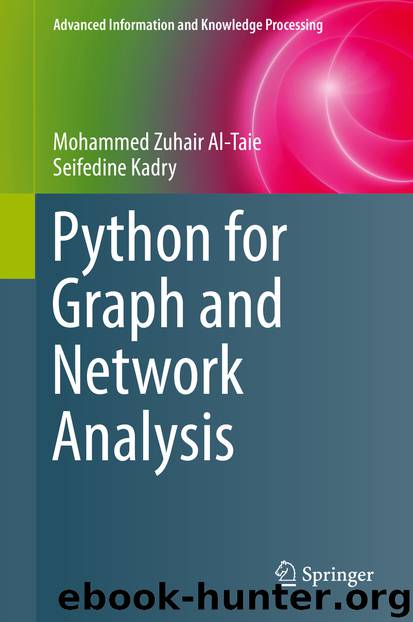Python for Graph and Network Analysis by Mohammed Zuhair Al-Taie & Seifedine Kadry

Author:Mohammed Zuhair Al-Taie & Seifedine Kadry
Language: eng
Format: epub
Publisher: Springer International Publishing, Cham
4.12 Social Network Analysis Modeling Tools
Social network analysis modeling tools are software packages that can be used to identify, represent, analyze, and visualize social networks. Examples include Pajek: software for analysis and visualization of large networks, UCINET, StOCENT, Gephi, Network Workbench, and NodeXL.
Special-purposes SNA modeling tools can be used to carry out particular analysis tasks such as the identification of subgroups, knowledge networks, hidden populations, kinship networks, and structural networks. Examples include NEGOPY, InFlow, and SocioMetric LinkAlyzer. Some modeling tools have programming utility such as NetworkX, JUNG, iGraph, Prefuse, and SNAP.
Because most of the concepts and techniques that social network analysis is based on are taken from mathematical graph theory, it is indispensable to spend some time briefing the main concepts in graph theory.
The main goal of SNA is to find local and global patterns, identify influential actors, and investigate network dynamics. Therefore, SNA is involved in the analysis of ties between people, organizations, and even countries.
Throughout the following three chapters, we will go through three levels of analyses including finding key players in the social network at the ego (individual) level, detecting distinctive communities in networks at the group level, and finally implementing cohesion analyses at the network level.
Download
This site does not store any files on its server. We only index and link to content provided by other sites. Please contact the content providers to delete copyright contents if any and email us, we'll remove relevant links or contents immediately.
Hello! Python by Anthony Briggs(10200)
The Mikado Method by Ola Ellnestam Daniel Brolund(10108)
OCA Java SE 8 Programmer I Certification Guide by Mala Gupta(10044)
Algorithms of the Intelligent Web by Haralambos Marmanis;Dmitry Babenko(8589)
Sass and Compass in Action by Wynn Netherland Nathan Weizenbaum Chris Eppstein Brandon Mathis(7969)
Grails in Action by Glen Smith Peter Ledbrook(7942)
Test-Driven iOS Development with Swift 4 by Dominik Hauser(7900)
The Well-Grounded Java Developer by Benjamin J. Evans Martijn Verburg(7843)
Windows APT Warfare by Sheng-Hao Ma(7674)
Layered Design for Ruby on Rails Applications by Vladimir Dementyev(7407)
Blueprints Visual Scripting for Unreal Engine 5 - Third Edition by Marcos Romero & Brenden Sewell(7306)
Secrets of the JavaScript Ninja by John Resig Bear Bibeault(6740)
Kotlin in Action by Dmitry Jemerov(5369)
Solidity Programming Essentials by Ritesh Modi(4476)
Hands-On Full-Stack Web Development with GraphQL and React by Sebastian Grebe(4403)
WordPress Plugin Development Cookbook by Yannick Lefebvre(4286)
Unity 3D Game Development by Anthony Davis & Travis Baptiste & Russell Craig & Ryan Stunkel(4197)
Functional Programming in JavaScript by Mantyla Dan(4171)
The Ultimate iOS Interview Playbook by Avi Tsadok(4167)
